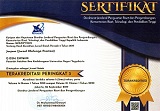The relationship between anthropometry and biomotor ability on gymnastics potential at SD Negeri 1 Gentan
Abstract
This study aims to analyze the relationship between anthropometric variables and biomotor abilities with gymnastics potential in elementary school students. The research method used a correlational quantitative approach involving 106 fourth and fifth grade students aged 9–11 years at SD Negeri 1 Gentan. Data were collected through anthropometric measurements (height, weight, arm span, sitting height) and biomotor ability tests (flexibility, core muscle strength, coordination). Data analysis was performed using Pearson's correlation test and multiple regression using SPSS. The results of the study showed that: (1) Height was significantly correlated with arm span (r = 0.687; p < 0.01) and sitting height (r = 0.434; p < 0.01), but not with biomotor ability; (2) Sit height has a positive relationship with core muscle strength (plank) (r = 0.346; p < 0.01), while arm span has a negative correlation (r = -0.209; p < 0.05); (3) Biomechanical abilities such as flexibility (split) and body rotation (air turn) are significantly correlated (r = 0.775 and r = 0.676; p < 0.01), but are not directly influenced by anthropometric variables. The conclusions of this study indicate that gymnastics potential is more influenced by technical training and flexibility than by body structure, although certain anthropometric variables such as sitting height and arm span play a role in core muscle stability. The implications of this study highlight the importance of combining anthropometric monitoring with structured biomotor training programs for the development of gymnastics potential in elementary school students.
Keywords: Anthropometry, Biomotor, Gymnastics, Elementary School, Talent Guidance.
Downloads
Published
How to Cite
Issue
Section
License
Copyright (c) 2025 Baskoro Bisma Yoga, Ria Amelia Karo Karo, Tsadila Marchlusiana, Elisa Putri Arsi, Elmalia Virdania Putri, M. Luqman Ahda, Muhammad Fakhri, Muhammad Irvan Eva Salafi, Abdul Alim, Herwin, Okky Indera Pamungkas, Ari Iswanto, Ridho Gata Wijaya, Wisnu Nugroho, Muhammad Wahyu Arga

This work is licensed under a Creative Commons Attribution-ShareAlike 4.0 International License.
Authors who publish with this journal agree to the following terms:
- Authors retain copyright and grant the journal right of first publication with the work simultaneously licensed under a Creative Commons Attribution License that allows others to share the work with an acknowledgement of the work's authorship and initial publication in this journal.
- Authors are able to enter into separate, additional contractual arrangements for the non-exclusive distribution of the journal's published version of the work (e.g., post it to an institutional repository or publish it in a book), with an acknowledgement of its initial publication in this journal.
- Authors are permitted and encouraged to post their work online (e.g., in institutional repositories or on their website) prior to and during the submission process, as it can lead to productive exchanges, as well as earlier and greater citation of published work (See The Effect of Open Access).




